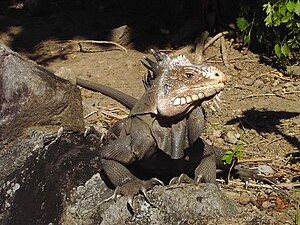Iguana is a type of lizard which consists of two species and is found in tropical areas of Central and Southern America as well as some of the Caribbean islands. The two species of Iguana which will be briefly assessed are: the Green Iguana and the Lesser Antillean Iguana.
These herbivorous reptiles have a dewlap (fold of skin which hangs under the throat and which helps in the regulation of the body temperature), a row of spines which run down their back and end at the tip of the tail, spikes behind their head and a delicate ear on each side which lays lower behind the eye.
The diet of these animals (both species) consists of leaves, flowers, fruit and many other species of plants.
1) The Green Iguana:
Green Iguanas are very good climbers and can fall from great heights without getting hurt. They are also talented swimmers; gliding through the water by moving their strong and powerful tail from side to side.
Their vision in low-light is fairly weak but instead they have special cells which give them a strong vision; so strong that they can even see the ultraviolet wave lengths. This aids them in making sure that they absorb enough sunlight in order to produce enough Vitamin D (which prevents bone diseases).
Strangely, Green Iguanas have a third eye on the top of their head which can only detect movement. This is very useful as it can detect predators that might be stalking it from above.
The Green Iguana’s main predators are hawks. These Iguanas are so frightened of hawks so that when the bird screams or whistles, the Iguana freezes, making it easier to be captured. Generally when the Green Iguana is threatened, it will try to escape (either by running or swimming away if water is close-by). At times it will try to threaten the predator by puffing up its body (in order to look bigger) and making sounds or even striking at it, using its powerful tail, sharp claws or its strong bite.
A strange fact is that, if a Green Iguana is grabbed on the tail by the predator it has the ability to break its tail. It will then escape and the tail will re-grow. This is useful for a creature which has to carry an approximately 80 centimeter tail everywhere it goes!
Despite its name (Green Iguana), the color of this specie varies according to the region which it lives in. It can be found in pink, orange, blue, black and a few other colors.
2) The Lesser Antillean Iguana:
This specie of Iguana which is between 1.2 and 1.5 meters in length, lives in woodlands, rainforests and mangroves of the



No comments:
Post a Comment